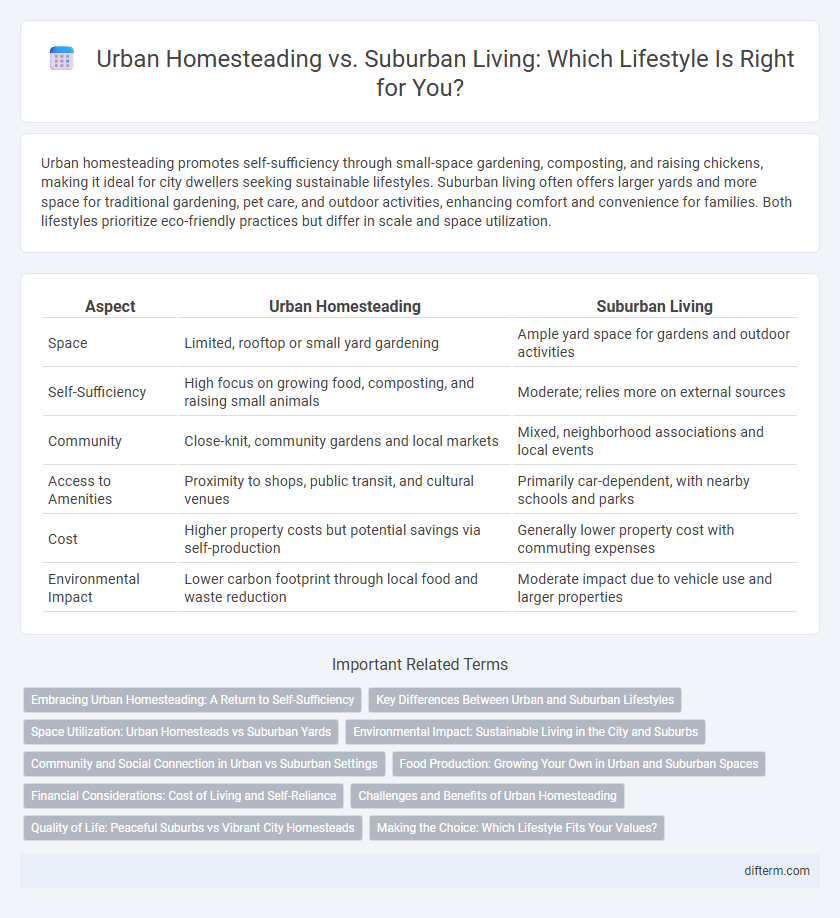Urban homesteading promotes self-sufficiency through small-space gardening, composting, and raising chickens, making it ideal for city dwellers seeking sustainable lifestyles. Suburban living often offers larger yards and more space for traditional gardening, pet care, and outdoor activities, enhancing comfort and convenience for families. Both lifestyles prioritize eco-friendly practices but differ in scale and space utilization.
Table of Comparison
| Aspect | Urban Homesteading | Suburban Living |
|---|---|---|
| Space | Limited, rooftop or small yard gardening | Ample yard space for gardens and outdoor activities |
| Self-Sufficiency | High focus on growing food, composting, and raising small animals | Moderate; relies more on external sources |
| Community | Close-knit, community gardens and local markets | Mixed, neighborhood associations and local events |
| Access to Amenities | Proximity to shops, public transit, and cultural venues | Primarily car-dependent, with nearby schools and parks |
| Cost | Higher property costs but potential savings via self-production | Generally lower property cost with commuting expenses |
| Environmental Impact | Lower carbon footprint through local food and waste reduction | Moderate impact due to vehicle use and larger properties |
Embracing Urban Homesteading: A Return to Self-Sufficiency
Urban homesteading enhances self-sufficiency by integrating sustainable practices such as container gardening, composting, and rainwater harvesting in limited city spaces. Unlike suburban living, which often relies on external resources, urban homesteaders prioritize local food production and energy-efficient solutions to reduce their environmental footprint. This lifestyle shift promotes resilience, food security, and a deeper connection to the urban environment.
Key Differences Between Urban and Suburban Lifestyles
Urban homesteading emphasizes sustainable living through small-space gardening, renewable energy use, and community involvement within dense city environments, contrasting with suburban living's more spacious properties, reliance on cars, and conventional utility infrastructure. Urban residents often prioritize walkability, public transit, and local food sourcing, while suburban dwellers benefit from larger yards, private garages, and greater privacy but face longer commutes. These distinctions influence lifestyle choices, environmental impact, and social dynamics between urban and suburban settings.
Space Utilization: Urban Homesteads vs Suburban Yards
Urban homesteading maximizes small spaces through vertical gardens, container planting, and rooftop farming, transforming limited square footage into productive green areas. Suburban yards typically offer expansive lawns and traditional garden plots, providing ample room but often underutilized for intensive food production. Efficient space utilization in urban homesteads supports sustainable living goals by integrating food growth into everyday environments, contrasting with the more leisurely, less dense use of suburban outdoor areas.
Environmental Impact: Sustainable Living in the City and Suburbs
Urban homesteading significantly reduces environmental impact by promoting sustainable practices such as rooftop gardening, rainwater harvesting, and composting within city limits. Suburban living tends to increase carbon footprints due to larger property sizes, greater reliance on vehicles, and less efficient land use. Emphasizing localized food production and resource conservation in both settings is crucial for advancing eco-friendly lifestyles and mitigating climate change effects.
Community and Social Connection in Urban vs Suburban Settings
Urban homesteading fosters tight-knit community bonds through shared resources, neighborhood gardens, and local markets, enhancing social connection among diverse populations. Suburban living often offers spacious environments but can lack the organic interactions and communal activities found in urban settings. The density and walkability of urban areas naturally encourage frequent social engagement and collaborative efforts in sustainable living.
Food Production: Growing Your Own in Urban and Suburban Spaces
Urban homesteading maximizes limited space with vertical gardens, container planting, and rooftop greenhouses, enabling fresh food production despite small footprints. Suburban living generally provides larger yards, offering more extensive garden plots and opportunities for diverse crops, including fruit trees and small livestock. Both lifestyles emphasize sustainable food sourcing, reducing carbon footprints, and fostering self-sufficiency through localized food production.
Financial Considerations: Cost of Living and Self-Reliance
Urban homesteading often reduces monthly expenses by enabling residents to grow their own food, harvest rainwater, and generate energy through solar panels, which lowers utility bills and grocery costs. In contrast, suburban living typically involves higher costs related to property taxes, commuting, and external food purchases, limiting opportunities for financial savings through self-reliance. Prioritizing self-sufficiency in urban homesteading enhances long-term financial resilience by decreasing dependency on conventional supply chains and fluctuating market prices.
Challenges and Benefits of Urban Homesteading
Urban homesteading offers unique benefits such as sustainable living, reduced food miles through local gardening, and enhanced community engagement in densely populated areas. Challenges include limited space for gardening, stricter municipal regulations, and potential higher costs associated with urban resources. Balancing these factors, urban homesteaders often develop innovative solutions to maximize efficiency and sustainability within compact living environments.
Quality of Life: Peaceful Suburbs vs Vibrant City Homesteads
Urban homesteading offers a vibrant lifestyle rich with community engagement, local markets, and diverse cultural experiences, enhancing overall quality of life through active urban participation. Suburban living provides a peaceful environment characterized by spacious yards, quieter streets, and access to nature, promoting relaxation and mental well-being. Choosing between these lifestyles depends on individual preferences for social interaction intensity and desire for urban amenities versus tranquility and space.
Making the Choice: Which Lifestyle Fits Your Values?
Urban homesteading offers sustainability and self-sufficiency through community gardens, rooftop farming, and local resource use, appealing to those who value environmental impact and close-knit neighborhoods. Suburban living prioritizes space, privacy, and access to schools and amenities, fitting families who seek convenience and a traditional residential environment. Evaluating priorities such as green living, social interaction, and lifestyle pace helps determine which setting aligns best with personal values and goals.
urban homesteading vs suburban living Infographic

 difterm.com
difterm.com